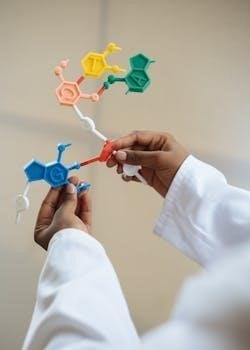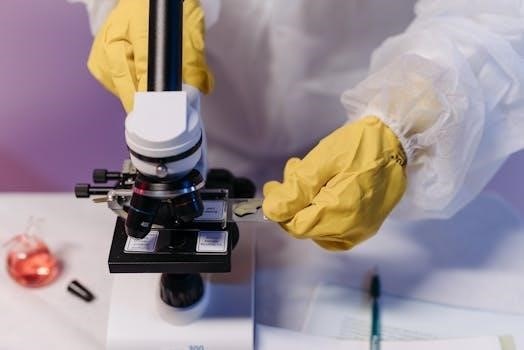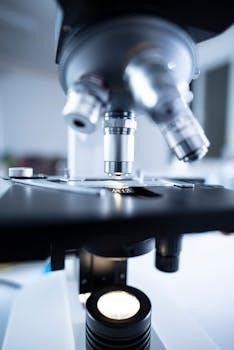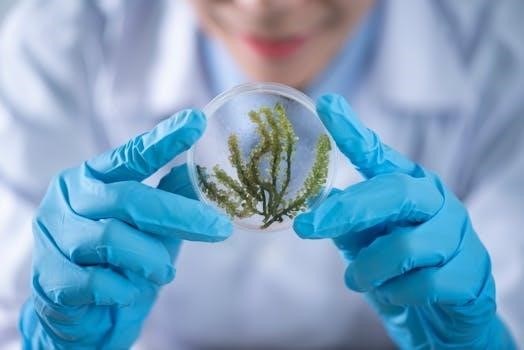Biology laboratory manuals are indispensable tools in the learning process. They offer a structured approach to experiment execution. These manuals guide students through essential procedures, ensuring a safe and effective laboratory experience. They also play a vital role in reinforcing theoretical knowledge.
Purpose of a Biology Lab Manual
The primary purpose of a biology lab manual is to provide a comprehensive guide for students conducting experiments. It serves as a detailed roadmap, outlining the steps, materials, and safety precautions necessary for each laboratory activity. These manuals aim to translate theoretical concepts into practical applications, allowing students to actively engage with the subject matter. They foster a deeper understanding of biological principles through hands-on experiences. Furthermore, lab manuals are designed to ensure consistency in the execution of experiments, which is crucial for obtaining reliable results. By standardizing procedures, they minimize variability and enable meaningful comparisons across student work. Beyond practical guidance, a well-structured lab manual also encourages critical thinking and problem-solving skills. Students are challenged to analyze experimental data, interpret results, and draw conclusions based on their observations. Ultimately, the purpose is to facilitate a meaningful learning experience that enhances both theoretical knowledge and practical skills in biology.
Importance of Lab Manuals in Learning
Lab manuals are crucial in learning because they bridge the gap between theoretical knowledge and practical application in biology. They provide a structured approach to learning, ensuring students follow proper procedures and understand the scientific method. These manuals enhance understanding by encouraging active participation and critical thinking. Students learn to analyze data, interpret results, and draw conclusions, improving their problem-solving skills. The use of lab manuals also fosters a deeper engagement with the subject matter, making learning more effective and memorable. Furthermore, they promote a sense of responsibility and accountability in the laboratory, as students are guided through each experiment step-by-step. This also promotes safety awareness and encourages adherence to protocols. Ultimately, lab manuals serve as a valuable resource, facilitating a more comprehensive and enriching learning experience in the field of biology, ensuring students develop both theoretical understanding and hands-on practical skills.

Essential Components of a Biology Lab Manual
A biology lab manual typically includes safety guidelines, detailed lab techniques, and specific experimental protocols. These components are fundamental for conducting safe and accurate scientific investigations. They are absolutely necessary.
Safety Procedures and Guidelines
Safety procedures and guidelines are a critical section within any biology lab manual. They are paramount for protecting students and instructors from potential hazards. These sections typically outline the necessary precautions to take when handling chemicals, biological specimens, and laboratory equipment. It is very important to remember to familiarize oneself with the manual prior to the laboratory session. Specific instructions on proper waste disposal, including biohazardous materials, are always included. The manual should also emphasize the importance of wearing appropriate personal protective equipment (PPE), such as gloves, lab coats, and safety glasses. Emergency protocols, including the location of safety showers and eyewash stations, are also detailed. These procedures ensure a safe and controlled environment for all experiments. Adhering to these rules is crucial for preventing accidents and injuries in the lab. Students must remember to follow all directions in the manual.
Lab Techniques and Methods
Lab techniques and methods form a core part of any biology lab manual, providing a detailed explanation of the practical skills needed for experiments. This section offers step-by-step guidance on various procedures, such as using a microscope, preparing solutions, and performing titrations. The manual often includes detailed instructions on molecular biology techniques, like PCR and electrophoresis, crucial for modern biological research. It also emphasizes aseptic techniques to avoid contamination, particularly in microbiology experiments. Furthermore, this section provides insight into the proper handling of lab equipment, ensuring accurate results and the longevity of the instruments. Mastering these techniques through careful study of the manual is essential for successful laboratory work. It lays the groundwork for students to develop hands-on competence in biological research. Understanding these procedures ensures accurate and reliable results.
Experimental Protocols and Procedures
The experimental protocols and procedures section of a biology lab manual provides detailed instructions for conducting experiments. This section outlines each step of an experiment, from preparation to data collection and analysis. It includes specific information about materials needed, the correct sequence of actions, and crucial timings. The protocols often include safety precautions, ensuring that students understand risks associated with the experiment. This section also specifies how to set up controls and replicates, ensuring the scientific validity of results. Proper adherence to these procedures is fundamental to achieving reliable data and drawing accurate conclusions. The lab manual aims to standardize the experimental process, leading to reproducible results. Students are expected to follow instructions meticulously to avoid errors. Therefore, this section is crucial for students to gain hands-on experience in conducting experiments properly and efficiently.

Specific Topics Covered in Biology Lab Manuals
Biology lab manuals often cover microscopy techniques, including slide preparation and observation. Molecular biology, with its complex methods, is also a key topic. Furthermore, herbarium preparation is another area of study.

Microscopy Techniques
Microscopy techniques are a cornerstone of biology lab manuals, offering students a hands-on approach to exploring the microscopic world. These sections typically detail the proper use and handling of various types of microscopes, from basic light microscopes to more advanced models. Students learn the art of slide preparation, encompassing the techniques for creating wet mounts, staining specimens, and ensuring optimal viewing conditions. The manual guides them through adjusting the microscope’s components, such as the objective lenses, condenser, and light source, to achieve clear and focused images. Detailed instructions are provided on how to calculate magnification and estimate the size of observed structures. Furthermore, microscopy sections often include exercises on identifying different cell types and their components, enhancing students’ understanding of cellular structures and functions. These skills are essential for visualizing and comprehending the intricacies of biological specimens, laying a foundation for further studies in biology.
Molecular Biology Techniques
Molecular biology techniques are a crucial part of modern biology lab manuals. These sections introduce students to the fundamental methods used in genetic analysis and manipulation. A core component often includes DNA extraction from various sources, detailing the chemical processes required to isolate and purify genetic material. Students learn about polymerase chain reaction (PCR), a method for amplifying specific DNA sequences, and how it is used in research. Gel electrophoresis is another frequently covered technique, teaching students how to separate DNA fragments based on their size. Furthermore, the manuals explore methods like restriction digestion and ligation, which are essential for gene cloning. These techniques are often presented within the context of human molecular biology, allowing students to appreciate their application in medical research. These practical exercises develop students’ skills for advanced study in molecular genetics and biotechnology.
Herbarium Preparation
Herbarium preparation, a traditional yet vital skill, is often included in biology lab manuals. This section guides students through the process of creating preserved plant specimens for long-term study and reference. The manuals describe the proper techniques for collecting plant samples in the field, emphasizing the importance of gathering representative parts such as flowers, fruits, and leaves. Detailed instructions are provided on how to press and dry plant specimens, often involving the use of blotting paper and specialized plant presses. The process of mounting specimens onto herbarium sheets is also explained, ensuring that specimens are securely attached and labeled with relevant information like the plant’s scientific name, collection date, and location. This section of the manual enables students to understand the value of botanical collections. They promote the understanding of plant diversity and classification, which are crucial in the study of botany and ecology.

Using and Understanding a Biology Lab Manual
Effectively using a biology lab manual requires careful reading and preparation. Understanding the provided protocols and safety procedures is essential for successful experimentation. Developing data analysis skills is also key for a better learning.
How to Effectively Use the Lab Manual
To maximize the benefits of a biology lab manual, begin by thoroughly reading each experiment before entering the laboratory. Pay close attention to the stated objectives, required materials, and step-by-step procedures. Familiarize yourself with safety protocols to ensure a secure working environment. Note any specific techniques or methods that will be employed. It’s also vital to understand the underlying principles of each experiment, this will assist in interpreting results. Before starting an experiment, ensure you have all necessary equipment and a clear workspace. During the experiment, follow each step meticulously, recording all observations and data accurately. Use the manual as a guide, but also think critically about each action. After completing the experiment, analyze your data carefully using the guide provided in the manual. Finally, reflect on the experiment’s results and any implications, using the manual to guide your conclusions and further studies.
Data Analysis Skills and Lab Manuals
Biology lab manuals are crucial for developing data analysis skills. They provide guidance on how to organize and interpret experimental results. Often, these manuals include examples of data tables, graphs, and statistical methods. By following these examples, students learn to effectively display and analyze collected data. The manuals also often explain how to identify patterns, trends, and relationships within the data. Learning to use the manual’s analysis guidance enables students to draw meaningful conclusions from their experiments. Through guided practice, the manuals help refine essential analytical abilities. Additionally, they may outline ways to calculate standard deviations, analyze histograms, and apply statistical tests. This helps students to present their findings clearly and accurately. The lab manual also promotes the ability to identify and address errors. This fosters critical thinking and problem-solving skills essential in science.
